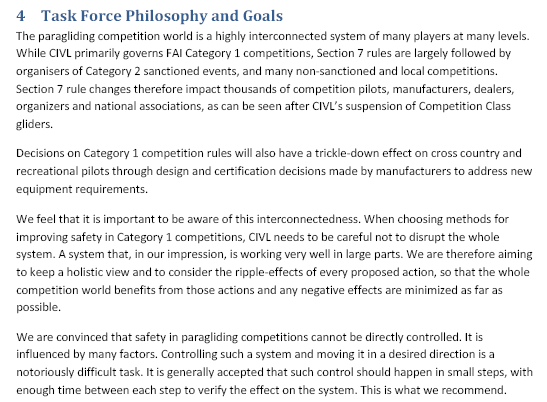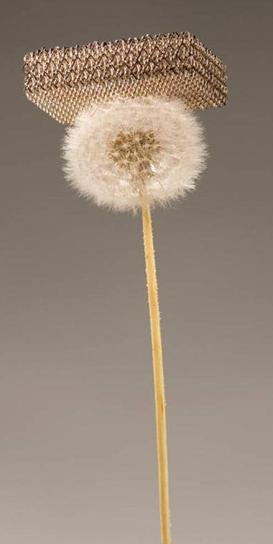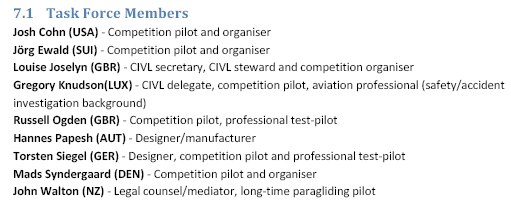|
Line Climber
Over 48 years ago,
one of the leading meditations
that kept my free-flight interest
was
the
following:
Be in the flats. Fly a kite while yet self-harnessed to the ground.
Once wing set is up very high, release self from ground contact and
rapidly climb the kite line toward the wing. Climb up the line faster than
the kite glides (paraglider system) down. Net result: be up in the
air gliding!
[[Definition legend: any gliding-kite system is a paraglider;
paragliders are gliding kites; wing
set w may use any known effective wing, airframed or not, any solidity.]]
 [[First brush with the idea actually came from reading someplace about
flying a LTA balloon that was not buoyant enough to lift oneself, but
fairly strongly lifting. I added: let the balloon lift a bead of mini-parachutes.
Then for fun: rapidly climb the line hanging from the balloon; see if one
can climb up faster than the balloon comes down and beaded chutes come
down. Highly physical! Sprint up the line and see how high one could get
before touching ground again. Sprint climb to the sky! ~JpF]] [[First brush with the idea actually came from reading someplace about
flying a LTA balloon that was not buoyant enough to lift oneself, but
fairly strongly lifting. I added: let the balloon lift a bead of mini-parachutes.
Then for fun: rapidly climb the line hanging from the balloon; see if one
can climb up faster than the balloon comes down and beaded chutes come
down. Highly physical! Sprint up the line and see how high one could get
before touching ground again. Sprint climb to the sky! ~JpF]]
Now use that principle perfected in high-performance kiting for a
paraglider climbing session:
Anchor self well to the ground; kite the wing (possibly multi-winged).
Control the wing by radio-control. Wait for the passing thermal.
When the wing is coring the thermal and lift is super, then disconnect
from the flats and use an assist electrical motor for ascending the
up-going system's main line. Get up to the place wanted on the line
(collecting the tether as you ascend; use the line later, perhaps).
Continue regular thermal soaring. Discuss this also at
ParaGlidingUnlimited, worldwide open forum at
THIS FORUM POST.
Upon wanting to land, have a couple of choices:
1. If you have a soft-canopy string-controlled wing:
somewhat reverse the process: One option: While far up high,
drop yourself on the long line (choose with parachute or not) and get near
the ground; then as the system descends, just before reaching the ground:
activate the ascender-assist motor to cause a touchdown that is near zero
fall rate; then radio-control the wing set to low-lift morph while
bringing down the wing set to ground. Call it a day of soaring.
2. If you have an airframed wing in the system,
then just glide the wing to ground.
This tactic could be used to lift oneself out of urban building
ravines, off urban streets, off urban parks, off urban roads, out of prison
yards, out of traps where fire or danger is encircling one, out of
confined forests, etc.
(Note: When played right, a segment of the long tether could be bungee;
let the thermal lift stretch the bungee; use the stored energy in the
stretched bungee section for rapid
first lift-off (extraction) when disconnecting from the ground as you also operate the
assisting-ascending motor.)
JpF, Dec. 3, 2011.
[[Ed: This might be one solution to the
PDMC in inland thermic airs.]]
Replace tow-me-up with this method of self-contained climbing the
paraglider main long-line.
Backstory: Prior to that 48 years was 9 years of
gliding through the air following high jump takeoffs; the tens of
thousands of flights prepared my psyche for above meditations.
Now in 2000s the flow has brought a participation in kite energy and new
aviation via kite systems and gliding-kite systems (airframed and
non-airframed wing sets). Line-climber launch:
A RELATED dynamic launch method is to anchor oneself to the ground; kite a
wing set very high; upon passing thermal, release pilot pod from ground
hold and use motorized line climber to make the long tether become short;
climb faster than the system sinks. Continue soaring.
Alternative: Without engine or motor: use pilot muscles in legs and arms
with line ascending devices. Discuss this in forum:
ParaGlidingUnlimited
forum in #32 topic thread. |
|
Dec. 8, 2011 Hi Guys,
I started to suggest the Norco hill also, but I didn't remember Volmer
ever being there. I flew little Norco, as it was then known, many times
during my HG flying years and it is also another place where I trained
myself to fly. It's the first place I flew my new Eipper FlexiFloater
(which I still have). Every so often, after flying the big mountain sites
for awhile, I would return to Little Norco and spend a day there just
goofing around and having fun flying a small hill, which could also become
soarable on many afternoons. Bob Wills flew there often because of that.
One time, with Bob W hovering motionless about ten feet above my head (me
standing on the ground) we had a long conversation about problems I was
having with a Wills Wing Swallow Tail.
The site is still there in its entirety (looking at Google Earth), landing
area and all. I think it is part of a natural area preserve, otherwise it
would have been turned into houses by now.
I stopped by there many years ago and R/C glider fliers were using the
site. I asked them about hang gliders and they said that in order for
permission use the hill they had to agree to run off any HG fliers that
showed up. That was a long time ago so I don't know what the situation is
now. I think it would be a great site for a vintage flying meet if
permission could be had. Maybe with USHPA insurance we could pull that
off. It's a perfect spot to fly old HG's. The wind usually blows straight
into the hill on average afternoons.
I am presently planning to re-visit three old small hill HG sites in Southern California
and get present day photos.
Next week I'm meeting Bill Liscomb to go to the top of the Vineyard St/San
Marcos (Vista) hill where I spent a lot of time with Richard Miller and
also flew my Skysail and Wills Wing SST. I have lots of photos of flying there
so I will get new shots showing the hill and the houses in the former
landing area. I go by there on my way to and from my desert cabin. I'm
going to visit the hill, with Bill L, next Tuesday when I'm on my way back
home (I'm in the desert now).
My granddaughter and her kids now live on the former Escape Country land
(isn't that a coincidence?) Again, the "500-Foot Hill" launch site is
still there, but with houses in the old landing area. Dave Cronk asked me
to send him my new shots when get them.
The third site I plan to visit is Little Norco. On a clear day I see it
from the I-15 freeway and Google Earth shows all of the land still vacant.
There are lots of trails so it looks like there's public access. The
Vineyard St hill, in San Marcos, also has lots of well used looking
trails. I'll know about that next Tuesday.
Now that I have scanned all of my old HG slides, and looked again at
photos of flying at those sites, it's going to be fun to see the old sites
again and get new photos. I may fly an electric R/C glider from the
Vineyard St hill if it looks feasible.
Frank Colver
See my comments about Little Norco in the above
note..
I never flew Big Norco as was never sure just how to
get there. I think access was closed fairly soon after HG flying started
there. Bob Wills would come out to Little Norco when he thought the
afternoon wind coming through Santa Ana Canyon would make it soarable.
That little hill was great when the west wind would get to 12mph and
above.
Scott Strom and I went to the tenth anniversary of HG
meet, at Torrey, together. That's where I got those photos of Dave
Kilbourne flying my Eipper. After that I saw him several times at
Interbike shows (Pete Brock also). I haven't had contact with Scott in
many years now. Don't know if that is his glider or not.
Frank Colver
Two
different versions of rework on image:
-
1, http://energykitesystems.net/Lift/hgh/images/PhotoFly.pdf
of centerfold of
Low & Slow #12
- 2, Also a recent
color-touch redux? by Neil of the image:

Reference to Low & Slow #12 centerfold color Photo-Fly-In...?
Hang gliding historian Neil Larson traces gems in the Photo-Fly color
image:
This historic hang glider group photo published Dec.1972 in #12 Low
& Slow magazine:
From research in USHGA
magazine archives on DVD identities of people in this group photo
Top left black Rogallo group
are none other than Imperial Engine Works Hang Glider club
(founder) Bill
Liscomb flanked by
"Frenchy" (left) & (right) John Havens.
And at the very top of the
hill, Chris Talbot Jones in his (kit built from plans) Icarus II
Chris * an original SCHGA
member and then standing board member as club secretary.
At the Icarus wing tip is Doug
Carmichael (son of Bruce
Carmichael)
Below Doug is Dick Eipper in
his highly successful production model (red and gold) Flexi-Flyer by
Eipperformance.
right Icarus group sitting: Steve
Elliott , Taras
Kiceniuk, Jr., (sister) Katherine Kiceniuk, and Tom Dickenson.
Front (in blue): Volmer Jensen and Irv Culver: designers
of cantilevered VJ23 Swing Wing with plywood veneer leading
edge. Recall "Culver twist" affecting most all of hang gliding pitch
stability and safety.
Above Volmer in center are Taras
Kiceniuk, Sr. (right)
, Lloyd
Licher (center),
and Mrs.
Marie Licher
(left),
Kneeling in half-covered Colver Sailwing is ***Richard
Miller holding
small flying wing model "Thistledown" Behind Richard is Frank
Colver, builder of Colver Sailwing
holding large sail wing model.
To the left of Frank is Tom
Valentine and
Steve Lewis - co-builders of the Blackbird (a modified hang
loose design)-
In dark tee shirt is Ed
Barbeau, standing in front of his re-designed Hang Loose type 3-axis control biplane hang glider.
In light blue shirt is ***Jack
Lambie Hang
Loose designer builder. Boy in red jacket is Ed Barbeau, Jr. pilot
of biplane.
Finally at far left is Low
& Slow (LIFT) editor, hang gliding pioneer and living legend: ***Joe
Faust, holding
assorted notes.
( *** designates
co-organizers of the 1971 Otto Lilienthal Universal Hang Glider
Championships & 123rd Birthday Party.)
Very good research, Neil. Thank you! You probably noticed that my
Skysail is only half covered at that time. When I saw the photo
I thought how significant that Richard is kneeling inside my wing.
The model in my hand is the same one that I had at our
40th anniversary gathering at San Miguel Park last May.
~~Frank Attached are three of my scanned slides of Little Norco
flying. I've reduced the size but I'm reminding everyone if you want
a full resolution copy of any photo I send just let me know. I like
the action shot of my son Matt launching his Eipper there.
Another one is of me flying my Eipper Flexi Floater there and
a third shot showing the site layout viewed from the top. When I
look at Google Earth it still looks the same now.
It's amazing to think that standard Rogallos would not even make it
beyond the dirt road, at the bottom, and into the field beyond. It
was a thrill the first time I flew a higher performance glider out
into that field. Of course the down side was a longer carry back to
the top :-(
These photos were taken in
August or September of 1974. The date on the scanned slide is
the scanning date. When I filed my scanned photos I put dates in the
file names to keep the records straight.
I remember flying there by myself (no shuttle needed for small
hills) one fine day and I was having so much fun that I remember
packing up the Eipper with the sun already set and the full
moon hanging in the eastern sky.
I would sure like to fly my Eipper there again.
~Frank Colver
PS: It sure makes me think of that moment when you feel the
positive control bar pressure and you know your feet are about to leave
the ground. What a special moment in time for us normally earthbound
humans! Thanks to all who have made that possible for those humans who
choose to partake.
~Frank Colver
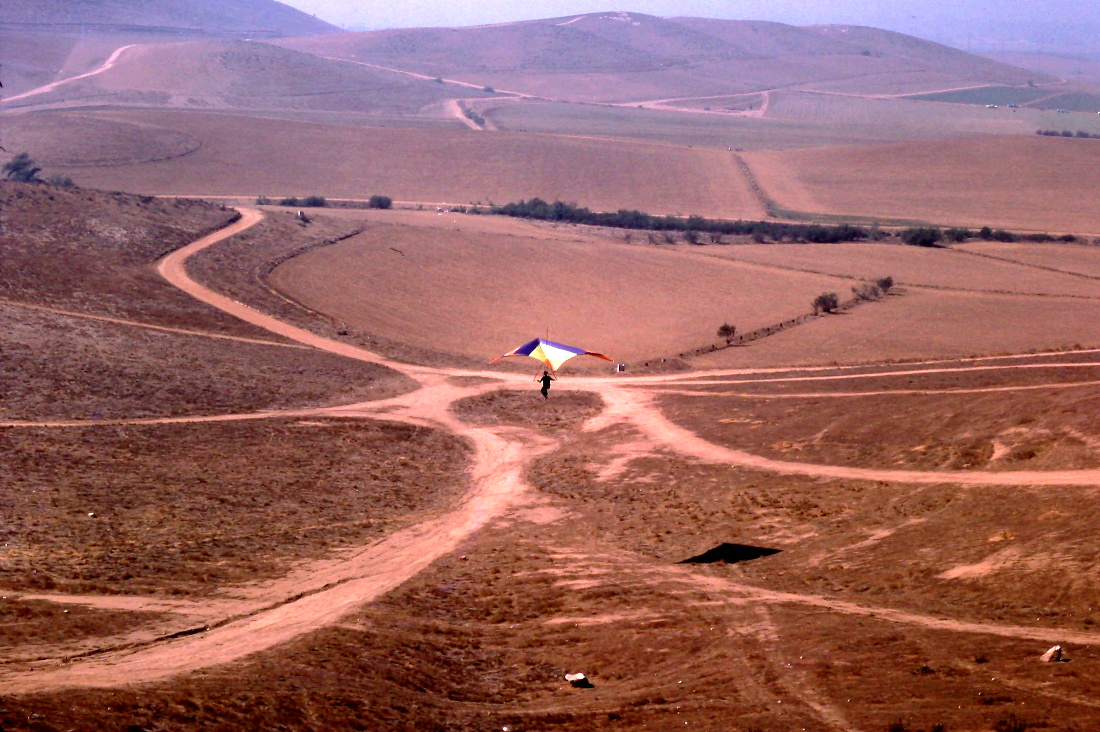
Above: Frank Colver at Little Norco, CA site
view
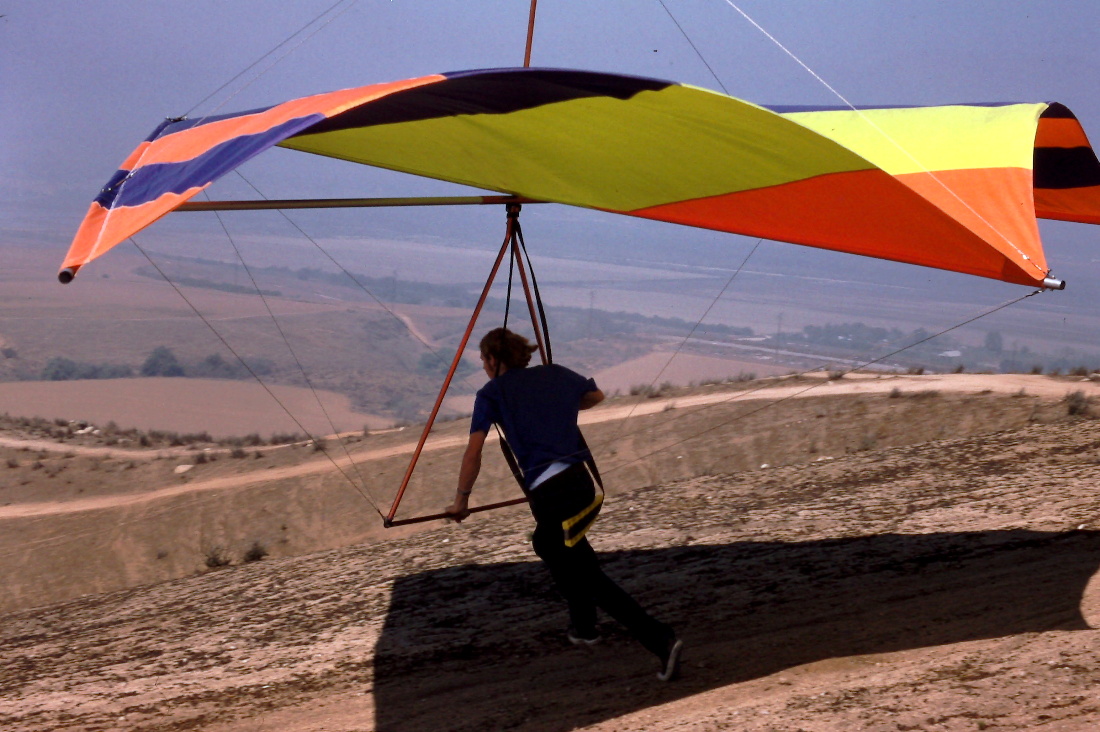
Above: Matt Colver launching
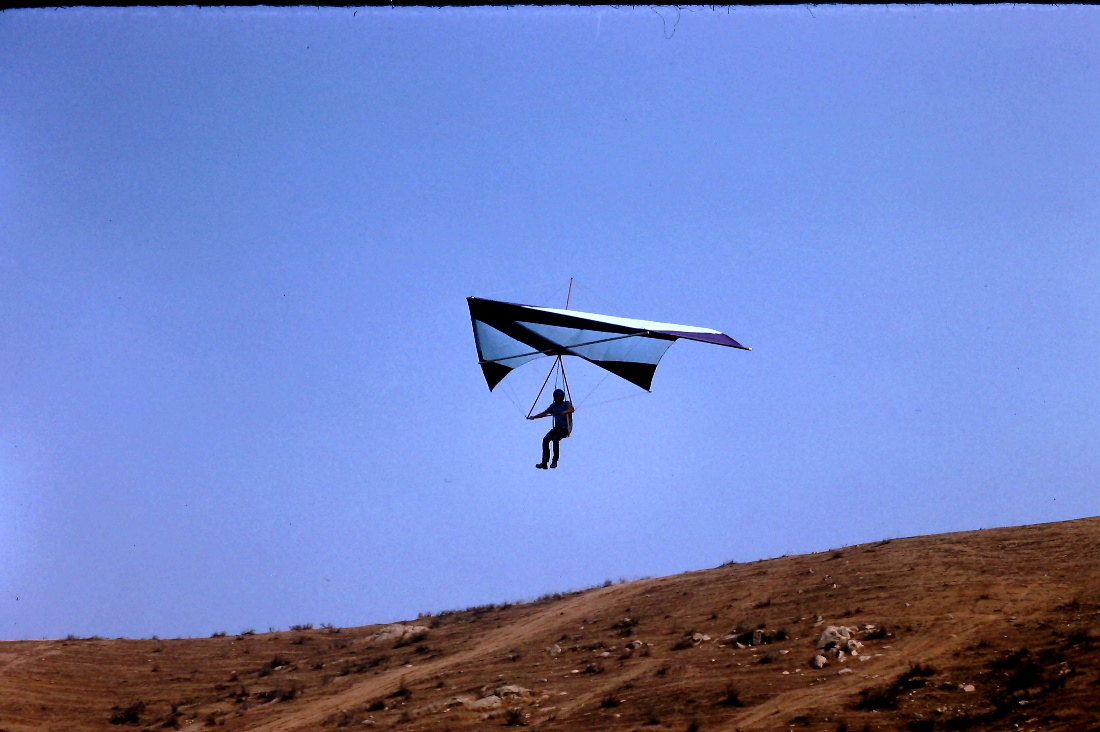
Frank Colver in Eipper-Formance Flexi Floater at Little Norco site in
Southern California |


